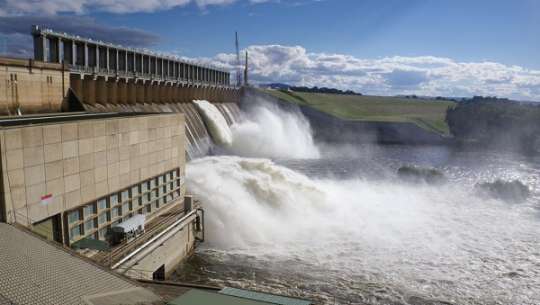Authorities in Burkina Faso have moved the scheduled spillage of the Bagre Dam forward by two days following heavy rainfall that pushed water levels to near-maximum capacity.
The controlled release, initially planned for Wednesday, August 27, will now begin on Monday, August 25, at 8:00 AM.
SONABEL, the power-producing company managing the dam, announced the schedule change after the Bagre Dam reached a filling capacity of 90.24 percent, just 0.73 metres below its maximum retention level. The decision came after recent heavy rainfall exceeded initial projections for water level increases.
As of Saturday, August 23, the dam stood at an elevation of 234.27 metres, representing the critical threshold that necessitated immediate action. The rapid rise in water levels caught authorities by surprise, prompting the emergency advancement of the spillage schedule.
The Kompienga Dam, also managed by SONABEL, has reached similarly concerning levels. The facility recorded water levels that left only 2.1 metres before reaching its normal retention mark, adding to flood risk concerns for downstream communities.
In a statement, SONABEL explained that the speed of water accumulation had exceeded expectations following the recent heavy rains across the region. “The water level has reached a critical threshold and requires a faster evacuation of the surplus,” the company stated.
The National Disaster Management Organisation (NADMO) in Ghana has been alerted about the schedule change, as the spillage typically affects communities along the White Volta River basin that extends into northern Ghana. The annual dam spillage has historically caused flooding in parts of the Upper East and Northern regions.
SONABEL has urged all downstream communities to remain vigilant and take necessary precautions against potential flooding. The agency emphasized that residents living in flood-prone areas should be prepared for possible water level increases following the spillage.
The Bagre Dam spillage occurs annually during Ghana’s rainy season when water levels in the reservoir exceed safe operational limits. The controlled release helps prevent catastrophic dam failure while managing water resources for hydroelectric power generation.
Ghanaian authorities have activated emergency response protocols in anticipation of the spillage. Communities along the White Volta have received warnings to monitor water levels closely and prepare for possible evacuations if conditions deteriorate.
The early spillage highlights the unpredictable nature of rainfall patterns in the Sahel region, where climate variability continues to pose challenges for water resource management. Heavy rains in recent days have filled reservoirs faster than anticipated across West Africa.
Emergency management officials stress that the controlled spillage, while necessary for dam safety, poses flood risks to thousands of people living downstream. The timing change reduces preparation time for affected communities, heightening the need for immediate precautionary measures.
The Bagre Dam, completed in 1994, serves as a crucial source of electricity for Burkina Faso while its spillage affects water levels across international borders. The facility’s management requires careful coordination between Burkina Faso and Ghana to minimize flood impacts.
Weather patterns suggest continued rainfall in the coming days, potentially maintaining high water levels even after the initial spillage. Authorities warn that additional releases may be necessary if precipitation continues at current levels.
The spillage underscores the broader challenges facing dam management in West Africa, where aging infrastructure must cope with increasingly erratic rainfall patterns attributed to climate change effects in the region.
Source: newsghana.com.gh











